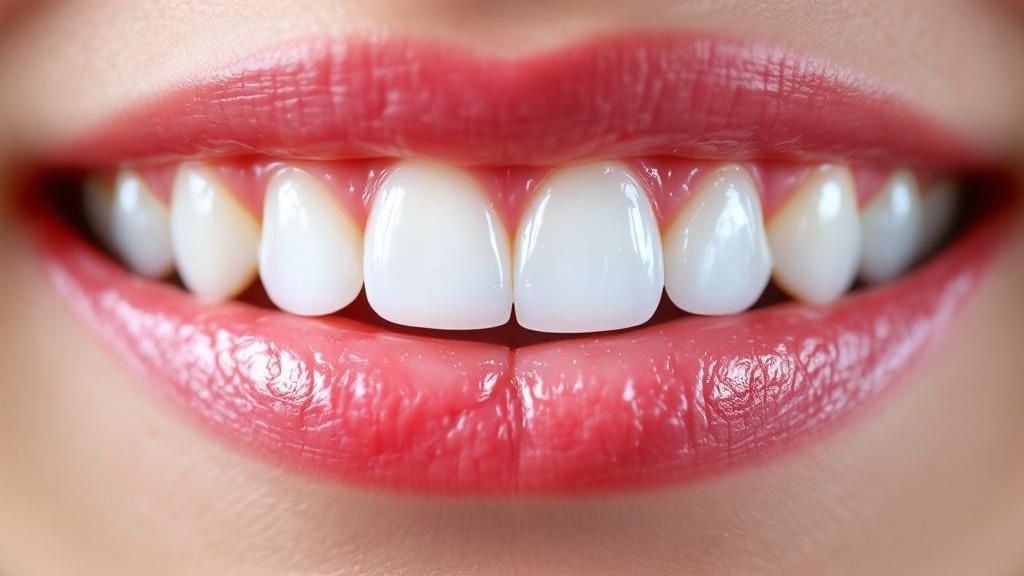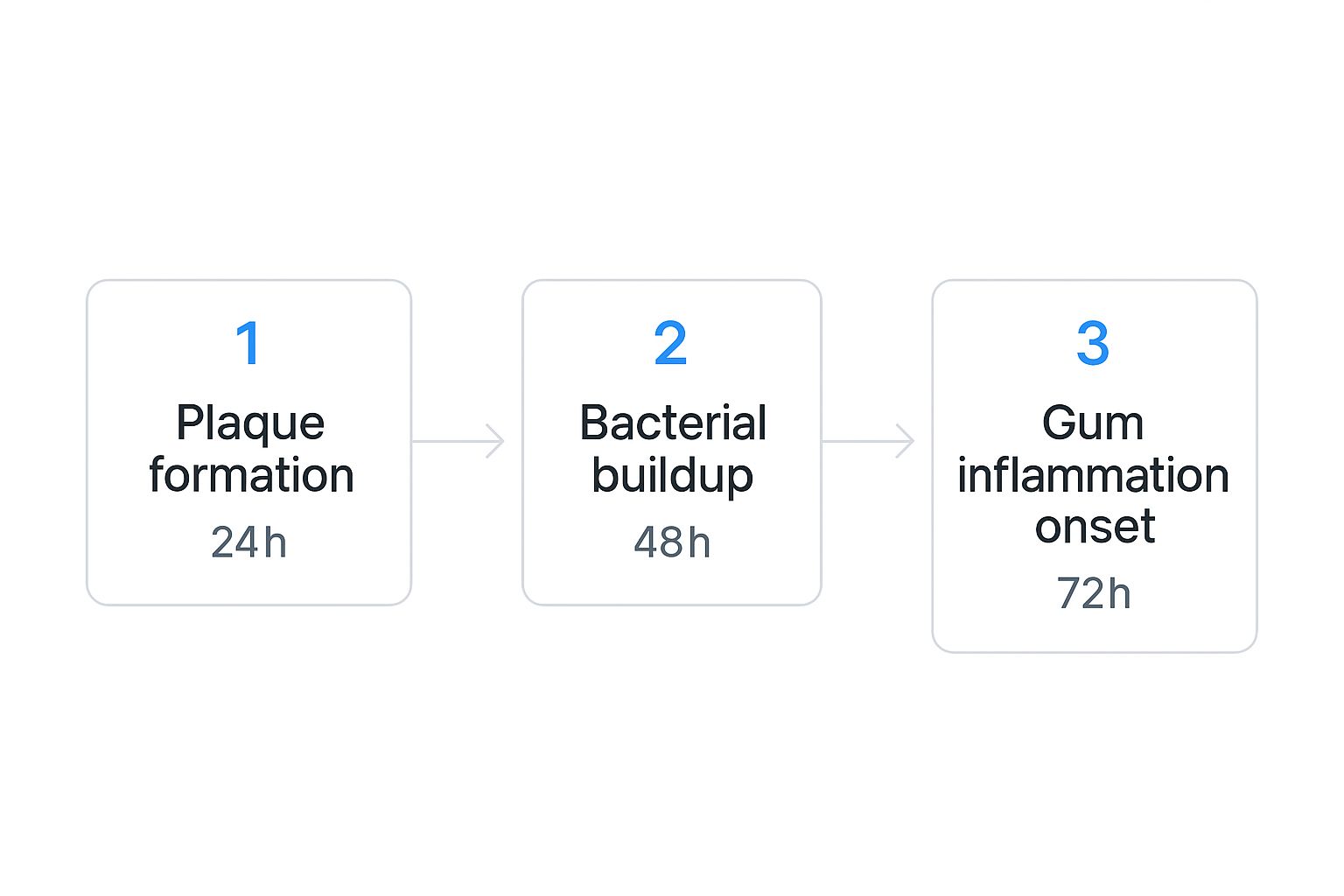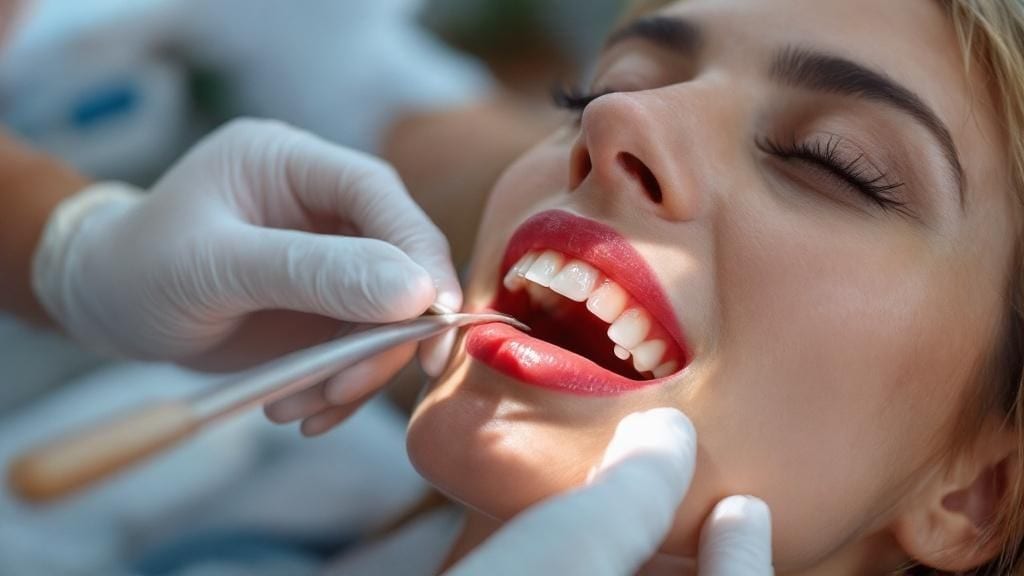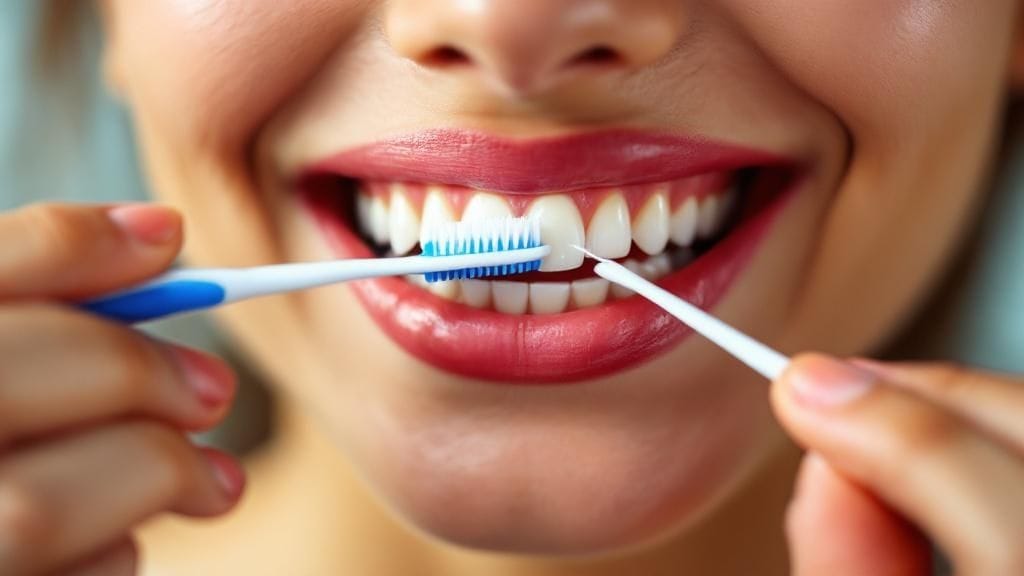If you’ve ever noticed a bit of pink in the sink after brushing your teeth, you’re definitely not alone. It’s often the first subtle sign of gingivitis, a very common and—this is the important part—completely reversible stage of gum disease. At its core, it’s simply an inflammation of your gums, usually caused by a buildup of bacterial plaque.
A Gentle Guide to Understanding Gingivitis

Hearing a dental term like “gingivitis” can sound a little intimidating. We get it. But as your local Wellington dental team, we’re here to reassure you that it’s far less scary than it seems.
Think of your gums as the foundation holding your teeth firmly in place. They provide the essential support that keeps your smile strong and stable. When your gums are healthy, they’re firm, pale pink, and fit snugly around each tooth, creating a protective seal. Gingivitis is your body’s way of sounding a gentle alarm, letting you know this foundation is becoming irritated.
What Is Happening at the Gumline?
The main culprit behind this irritation is dental plaque—that soft, sticky film of bacteria that’s always forming on your teeth. If it isn’t removed properly each day through good brushing and flossing, the bacteria in the plaque release toxins that cause your gums to become inflamed. You can find out more by reading everything you need to know about plaque and how to manage it.
This initial inflammation is what we call gingivitis. It’s the earliest stage of gum disease and, crucially, it’s the only stage that is fully reversible with professional care and improved oral hygiene at home.
The most important thing to remember is that gingivitis does not involve any loss of the bone or tissue that hold your teeth in place. It’s a surface-level inflammation that, when addressed promptly, can be resolved without any long-term damage.
At City Dentists, our caring team sees this condition all the time. We want to remove any anxiety you might feel and show you that with the right care, you can easily restore your gums to perfect health. Recognising the early signs is the first step toward maintaining a healthy, confident smile for life.
The Simple Causes Behind Gum Irritation
So, what kicks off gingivitis in the first place? The main culprit is often much simpler than people think: it all boils down to dental plaque.
Plaque is a soft, sticky, and almost invisible film of bacteria that’s constantly forming on your teeth. Everyone has it. When you don’t get rid of it effectively with daily brushing and flossing, these bacteria produce toxins that start to irritate your gum tissue. This irritation is the inflammation we call gingivitis.
If that soft plaque is left undisturbed, it can start to harden into tartar (also called calculus) within just a few days. Tartar is a tough, mineralised substance that creates a rough surface for even more plaque to cling to, which just makes the situation worse. And unlike plaque, you can’t remove tartar by brushing at home; it needs a professional clean from one of our friendly dentists or hygienists.
This whole process is surprisingly quick and straightforward. The infographic below shows just how rapidly plaque buildup can lead to gum inflammation.

As you can see, the journey from a clean mouth to the beginnings of gum inflammation can happen in as little as three days. This is exactly why your daily habits are your most powerful defence.
Other Factors That Increase Your Risk
While plaque is the primary offender, certain factors can make you more susceptible to gum irritation or change how your body responds to the bacteria. Knowing about these can help you stay extra vigilant with your oral care.
- Hormonal Changes: Big fluctuations during puberty, pregnancy, or menopause can make your gums more sensitive and far more likely to get inflamed in response to plaque.
- Smoking: This is a major one. Smoking weakens your body’s immune system, making it much harder to fight off gum infections. It also reduces blood flow to the gums, which can hide early warning signs of gingivitis like bleeding.
- Certain Medical Conditions: Conditions like diabetes can affect your body’s ability to fight infection in general, and that includes your gums.
- Medications: Some medications can reduce saliva flow. This leads to a dry mouth, which is the perfect environment for plaque to build up more easily.
It’s so important to see the connection between your oral health and your overall wellbeing. Factors that affect your whole body can absolutely have a direct impact on what happens in your mouth.
Beyond its direct harm to gum health, smoking carries numerous broader health risks associated with smoking cigarettes that really highlight the importance of quitting. If you’re concerned about how these factors might be affecting you, you can learn more about the risk factors in gum disease in our detailed guide.
How to Recognise the Early Warning Signs

Thankfully, your body gives you pretty clear clues when your gums need a bit more attention. Spotting what gingivitis looks like early on is the key to stopping it in its tracks, long before it has a chance to become a bigger problem. Our goal here is to help you know what to look for—without causing any alarm—so you can feel confident about when to seek some friendly advice from our Wellington dental team.
The most obvious sign is a change in how your gums look and feel. Healthy gums are typically a pale pink colour, firm to the touch, and fit snugly around your teeth. When gingivitis sets in, they often become red, swollen, and puffy because of the inflammation caused by plaque.
Common Symptoms to Look For
Beyond a visual change, other distinct signs can signal the beginning of gingivitis. Paying attention to these subtle shifts during your daily routine can make all the difference.
You might notice one or more of the following:
- Bleeding Gums: Seeing a bit of pink in the sink when you brush or floss is a classic giveaway. Healthy gums shouldn’t bleed with gentle cleaning.
- Gum Tenderness: Your gums might feel sore or tender, especially along the gumline where plaque loves to build up.
- Persistent Bad Breath: Known in the medical world as halitosis, a constant bad taste or odour that brushing doesn’t fix could point to underlying gum issues.
- Slight Gum Recession: While more common in advanced gum disease, you might see your gums starting to pull away from your teeth, making them appear longer.
For a deeper dive, you can explore our guide on the key signs of gum disease to become even more familiar with what to watch for.
It’s easy to brush off a little bleeding as the result of brushing too hard, but it’s often your gums’ way of telling you they’re inflamed and need attention. This is the perfect time to act.
It’s interesting to note that understanding exactly how common gingivitis is in New Zealand can be tricky. The 2009 New Zealand Oral Health Survey (NZOHS) provided some great baseline data, but it didn’t specifically report on gingivitis rates in adults. This lack of specific national data highlights why being able to recognise the symptoms yourself is so important, since we know gingivitis is the first step toward more serious gum disease.
If any of this sounds familiar, please don’t worry. This is simply your cue to fine-tune your oral hygiene routine and perhaps book a visit for a professional clean. At City Dentists, we’re here to help you get back to comfortable, healthy gums with gentle, reassuring care.
Our Approach to Treating Gingivitis in Wellington
If you’ve spotted some of the early warning signs of gingivitis, we want you to know the next step is straightforward and gentle. Here at City Dentists, your comfort is our top priority. We’ve built our approach around patient-focused care that’s thorough, clear, and designed to put you completely at ease.
Your journey back to gum health starts with a calm, careful examination. This isn’t just a quick peek; it’s a dedicated assessment where we gently check the health of your gums, note any inflamed areas, and measure the tiny spaces between your teeth and gums. This gives us a complete picture of what’s going on so we can plan the best way forward, together.
Your Personalised Treatment Plan
Once we have a clear understanding, we can get to work. The most important step in treating gingivitis is a professional dental cleaning. This is where our skilled and gentle hygienists truly shine.
They carefully remove every trace of plaque and—more importantly—the hardened tartar that you just can’t get rid of at home, no matter how well you brush. Think of it as a complete reset for your mouth, clearing away the build-up that’s been irritating your gums and giving you a fresh start.
After your cleaning, we’ll sit down and chat about a personalised plan. This usually includes:
- Practical Home Care Advice: We’ll show you effective brushing and flossing techniques that work for you, empowering you to keep your gums healthy long after you leave our clinic.
- Follow-Up Recommendations: We’ll suggest a schedule for future hygiene visits to keep your gums in top shape and stop any problems before they start.
- Addressing Specific Needs: If any other dental work is needed to help your gums, we’ll explain everything clearly. Sometimes, this involves taking traditional impressions to create things like perfectly fitting crowns, ensuring no tricky spaces are left for plaque to hide. We believe in using proven, reliable methods that deliver outstanding, long-lasting results.
Preventing Progression Is Key
Our goal isn’t just to treat the issue at hand but to stop it from getting worse. The progression from mild gingivitis to more serious periodontal disease is a genuine concern, and a professional diagnosis is the key to stopping it in its tracks.
In New Zealand, estimates for how many adults have periodontitis can vary wildly—from as low as 3% to as high as 59%, depending on how it’s defined. This huge range shows just how crucial an expert assessment is. Our trained Wellington team can accurately identify the stage of your gum disease and provide the right care to protect your long-term health. You can read the full research about these findings to learn more.
At City Dentists, we focus on patient-focused care. This means every step is explained, every question is answered, and your comfort guides everything we do. You are always in control of your dental health journey.
From your first exam to the final polish, we’ll make sure you feel informed, cared for, and confident. We believe understanding your options is vital, which is why we’ve put together a comprehensive overview of our approach to gum disease treatment in Wellington. We’re here to be your partners in achieving a healthy, happy smile.
A Practical Guide to Preventing Gingivitis for Good

Here’s the best news about gingivitis: it’s almost entirely preventable. The power to keep your gums healthy is literally in your hands, every single day. We want to give you a straightforward guide that goes beyond just saying “brush and floss” and offers simple, effective habits you can build for life.
It’s easier than you might think to turn prevention from a daily chore into an empowering habit. It all comes down to being mindful of your technique and understanding how these small actions protect your smile between visits to our Wellington practice.
Perfecting Your Brushing Technique
When it comes to brushing, it’s less about brute force and more about precision. A lot of us brush way too hard, which can actually damage our gums over time. The real key is to be gentle but thorough.
Here’s the method our hygienists always recommend:
- Choose the Right Tool: Always go for a toothbrush with soft bristles. Anything medium or hard can be too abrasive for your delicate gum tissue.
- Angle for Success: Hold your toothbrush at a 45-degree angle to your gums. This lets the bristles gently sweep plaque away from the gumline, right where it causes the most trouble.
- Use Gentle Motions: Think short, gentle, circular strokes instead of aggressive back-and-forth scrubbing.
The Importance of Daily Flossing
Flossing is absolutely non-negotiable for preventing gingivitis. Why? Because it cleans the spots your toothbrush just can’t reach—which is about 35% of your tooth surfaces. It’s the only way to get rid of the plaque and food bits trapped between your teeth and just under the gumline.
To get the most out of it, wrap the floss in a C-shape around each tooth. Then, slide it gently up and down, making sure you dip just below where the gum meets the tooth. If you’re not confident in your technique, we’ve got a great resource, A Dentist’s Guide on How to Floss Properly, with step-by-step advice.
Remember, consistency is far more important than intensity. A gentle, two-minute clean twice a day is infinitely better for your gums than a powerful scrub once in a while.
Supporting Your Gums from the Inside Out
Your daily habits don’t stop at the bathroom sink. What you eat and drink also plays a huge role in keeping your gums healthy and preventing the irritation that leads to gingivitis.
A balanced diet loaded with vitamins and minerals, especially Vitamin C, helps keep your gum tissue strong and resilient. Crunchy fruits and vegetables, like apples and carrots, act as natural tooth cleaners while you chew. Just as important is staying hydrated. Drinking plenty of water helps rinse away food particles and bacteria, giving your saliva’s natural cleaning power a boost.
By weaving these simple, practical steps into your daily routine, you create a powerful defence against gingivitis. It’s a proactive approach that ensures your smile stays vibrant and your gums remain healthy for years to come.
Answering Your Gingivitis Questions
We find that having clear, straightforward answers helps our patients feel confident and in control of their oral health. Here are some of the most common questions we hear at our Wellington clinic about gingivitis, answered simply.
Your Top Questions Answered
Can I Pass Gingivitis to Someone Else?
This is a great question. While you can’t “catch” gingivitis like a cold, the bacteria that cause it can be shared through saliva. Think kissing or sharing cutlery.
However, just because the bacteria are shared doesn’t mean the other person will automatically get gingivitis. It really comes down to their own oral hygiene habits and how their body responds. Your best defence is always looking after your own smile.
Will Gingivitis Go Away by Itself?
If you catch it incredibly early, stepping up your brushing and flossing game can sometimes be enough to turn things around. But it’s a small window.
Once that sticky plaque hardens into tartar (or calculus), it’s not coming off with a toothbrush. Only a professional clean can remove it. It’s always best to let your dentist have a look to make sure the problem is properly sorted and doesn’t progress.
How Quickly Can Gingivitis Be Cured?
After a professional clean here at our Wellington practice, combined with diligent care at home, you’ll notice a big difference quite quickly. Symptoms like bleeding and swelling should improve within one to two weeks.
Getting your gums back to being perfectly healthy usually takes a few more weeks of consistent brushing and flossing.
What Happens If Gingivitis Is Not Treated?
This is why we take it so seriously. If left unchecked, gingivitis can progress to periodontitis, which is a much more severe form of gum disease.
Periodontitis doesn’t just affect the gums; it starts to damage the soft tissue and bone that hold your teeth in place. In the long run, this can lead to loose teeth and even tooth loss. Catching gingivitis early is your best bet for protecting your long-term health.
Your Partners in Gum Health at City Dentists
We hope this guide has helped you understand what gingivitis is all about and, more importantly, feel reassured that it’s a very common and manageable condition. Our goal has always been to take the fear and uncertainty out of looking after your gums. We see it as a true partnership—one between you and our dedicated Wellington dental team, working together for a healthy smile.
The main thing to remember is that gingivitis is highly treatable and entirely preventable. You never have to figure it out on your own. Whether you’ve noticed a bit of pink on your toothbrush or you’re simply overdue for a check-up, please know our doors are always open. We’re here to offer expert care without judgement, in a comfortable and friendly environment.
Take the Next Step with Confidence
Looking after your oral health is a vital part of your overall wellbeing, and being proactive is something to be proud of. A simple consultation is the first step toward ensuring your gums stay healthy for the long run.
At City Dentists, we’re not just here to fix problems—we’re here to be your lifelong partners in care. We’re committed to helping you achieve and maintain a healthy, confident smile you’ll love sharing for years to come.
Don’t let a small worry turn into a bigger issue. Our friendly team is ready to answer your questions and provide the gentle, patient-focused care you deserve. Let’s work together to keep your smile bright and healthy.
Ready to take control of your gum health? Contact City Dentists today to book your consultation and experience our caring approach firsthand. You can schedule your visit easily through our website at https://www.citydentists.co.nz.
